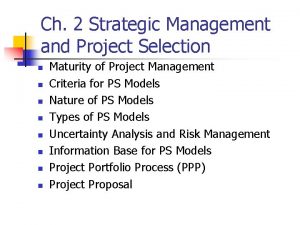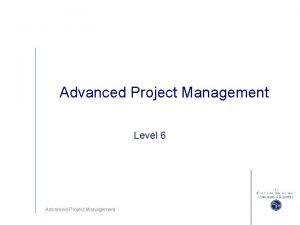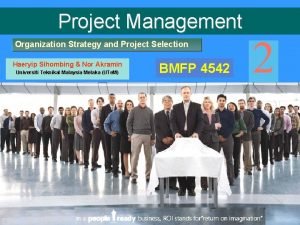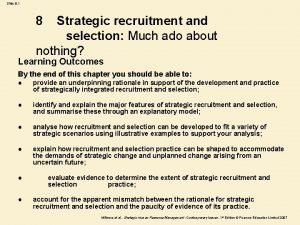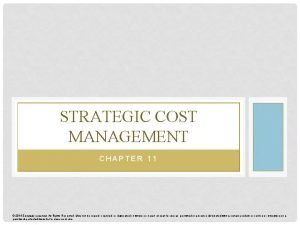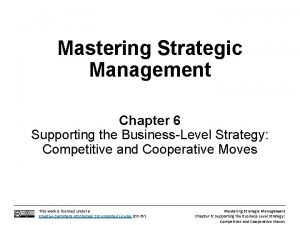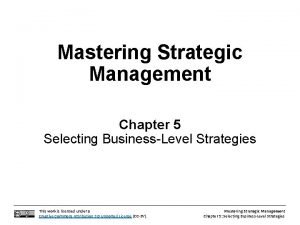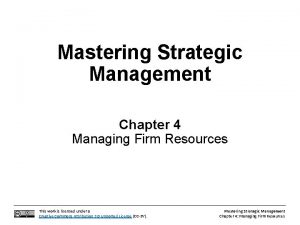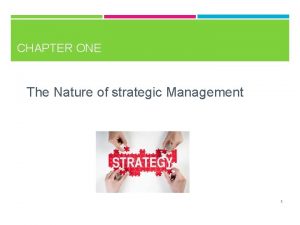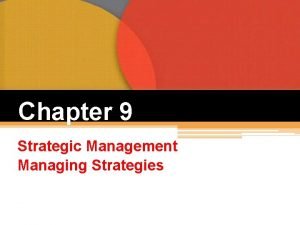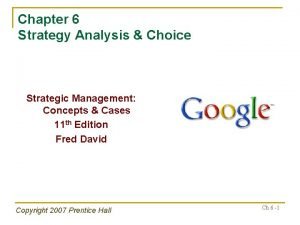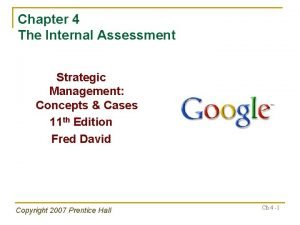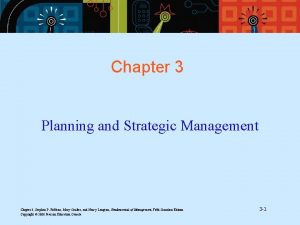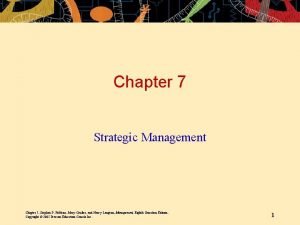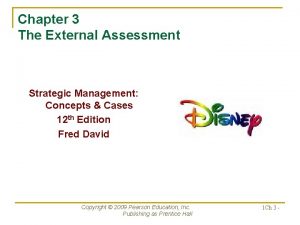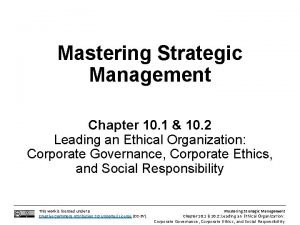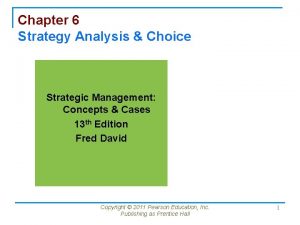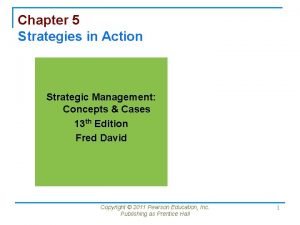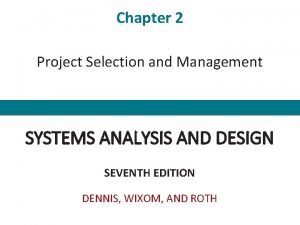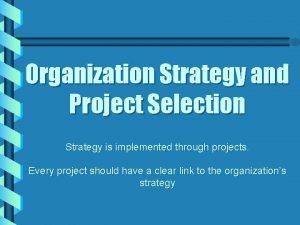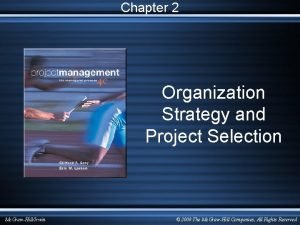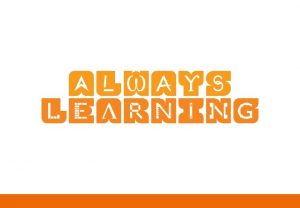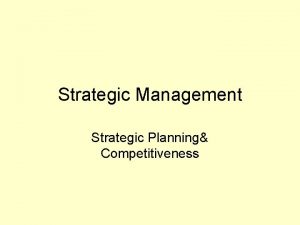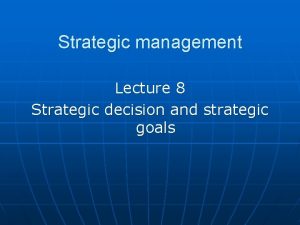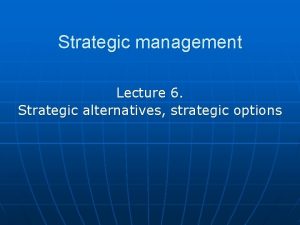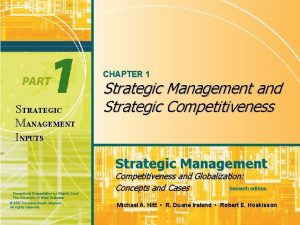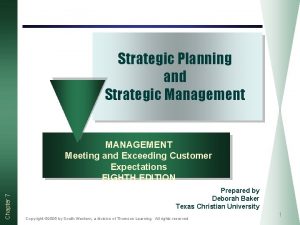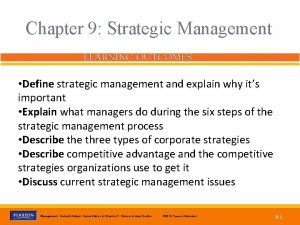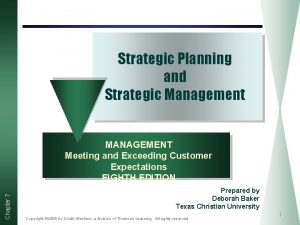Chapter 2 Strategic Management and Project Selection Copyright































![Internal Rate of Return [IRR] l l IRR is calculated with trial & error. Internal Rate of Return [IRR] l l IRR is calculated with trial & error.](https://slidetodoc.com/presentation_image_h/a8a8c6732aa731c429bc50de08b930d7/image-32.jpg)



























- Slides: 59

Chapter 2 Strategic Management and Project Selection Copyright 2009 John Wiley & Sons, Inc.

Strategic management l Why project manager need to understand strategy? – – To make appropriate decisions and adjustments. To make them effective project advocates.

Problems With Multiple Projects l l l Delays in one project delays others (because of common resource needs or technological dependencies. ) Inefficient use of resources (results in peaks and valleys of resource utilization. ) Bottlenecks in resource availability (or lack of required technological inputs result in project delays that depend on those scarce resources or technology. )

Project Results 30 Percent cancelled midstream l Over half of completed projects-190 percent over budget l Over half of completed projects- 220 percent late l

Challenges Making sure projects closely tied to goals and strategy l How to handle growing number of projects l How to make projects successful l

Project Selection and Criteria of Choice l l l Project selection is the process of evaluating proposed projects or groups of projects, and then choosing to implement some set of them so that the objectives of the parent organization will be achieved. E. g. A manufacturing firm can use evaluation/selection techniques to choose which machine to adopt in a partfabrication process; a TV station can select which of several syndicated comedy shows to rerun in its 7: 30 p. m. weekday time-slot; a construction firm can select the best subset of a large group of potential projects on which to bid. Each project will have different costs, benefits, and risks.

Models are used to select projects l All models simplify reality l That is, they only look at the key variables involved in a decision l The more variables included in a model, the more complex it becomes l Simpler models usually work better l

Why Project Selection Models? l l Companies only want to undertake successful projects Projects that fail waste resources and hurt profitability and competitiveness Projects that succeed improve profitability and competitiveness No model can predict with absolute certainty

Selection Models- Criteria Realism l Capability l Flexibility l Easy to use l Inexpensive l Easy to implement(computerisation) l

Realism l l Needs to include all objectives of the firm Needs to include the firms expertise as well as its limitations Should reflect the real situation Include factors like project risks, implementation risks and technical risks of performance, cost and time.

Capability l Model needs to be sophisticated enough to deal with all projects – – – l Varying resource requirements Varying time periods Varying probabilities of success Needs to be able to select the optimum projects among all contenders

Flexibility Needs to be able to work with all projects l Needs to be updated as the firm and its environment evolves l

Easy to Use Needs to be quick to gather the data and easy to use l Easy to be able to “fit” the project in the model l

Inexpensive Do not want the model to eat up all the savings that result from using the model l Expenses include the cost of writing and maintaining the model l Also includes the expense of gathering the data needed by the model l

Easy to Implement(computerisation) l A model to be used to evaluate all the firm’s projects should be centrally maintained

The Nature of Project Selection Models l l l Models turn inputs into outputs Managers decide on the values for the inputs and evaluate the outputs The inputs never fully describe the situation The outputs never fully describe the expected results Models are tools Managers are the decision makers

Types of Project Selection Models Numeric models l Nonnumeric models l

Numeric Models l l Models that return a numeric value for a project that can be easily compared with other projects Two major categories: 1. 2. Profit/profitability Scoring

Profit/Profitability Models l Models that look at costs and revenues – – l Payback period (PBP) Discounted cash flow (NPV) Internal rate of return (IRR) Profitability index (PI) NPV and IRR are the more common

Payback Period (PBP) It is defined as the number of years required for recovering the original cash outlay invested in a project. l The length of time until the original investment has been recouped by the project. l

Payback Period Example l A project costs $100, 000 to implement and has annual net cash inflows of $ 25, 000. Then calculate the payback period of the project.

Payback Period Example

Payback Period-Decision rule It has to be pre-determined the acceptable min. pay back period. l If the project PBP is shorter than acceptable PBP, the project is acceptable. l A shorter payback period is better. l

Payback Period

Example Calculation of the payback period for a given investment proposal. a) Prepare End of Year Cumulative Net Cash Flows b) Find the First Non-Negative Year c) Calculate How Much of that year is required to cover the previous period negative balance d) Add up Previous Negative Cash Flow Years Initial Investment 1 Alternative A (45, 000) 10, 500 a 2 3 11, 500 12, 500 End of Year Cummulative Net Cash Flow (45, 000) (34, 500) (23, 000) (10, 500) Pay Back Period Fraction of First Positive Year Pay Back Period Annual Net Cash Flows 4 5 6 7 8 9 10 13, 500 13, 500 3, 000 16, 500 30, 000 43, 500 57, 000 70, 500 84, 000 b 0. 78 3. 78 c) 0. 78 = 10, 500/13, 500 d) 3 + 0. 78

Payback Period Drawbacks 1. 2. 3. 4. Does not consider time value of money Less meaningful over longer periods of time (due to time value of money) Ignores the life of the project beyond the PBP. More difficult to use when cash flows change over time

Discounted Cash Flow (NPV Method) l l l This method determines NPV of all cash flows by discounting them by the required rate of return The value of a stream of cash inflows and outflows in today’s dollars Widely used to evaluate projects Includes the time value of money Includes all inflows and outflows, not just the ones through payback point Requires a percentage to use to reduce future cash flows - discount rate

NPV Formula A 0 : Initial cash investment (negative because this is an outflow) Ft : The cash flow in time period t k : The discount rate T : The number of years of life

NPV Formula Terms A higher NPV is better. l The higher the discount rate, the lower the NPV. l A project is acceptable if the sum of the NPV of all estimated cash flows over the life of the project is positive. Decision rule: l Accept if NPV is greater than 0. l Reject if NPV is lesser than 0. l

NPV Example l A project has $ 100, 000 investment with a net cash inflow of $ 25, 000 per year for a period of 8 years, a required rate of return of 15%, and an inflation rate of 3 % per year. Calculate NPV of the project.

NPV Example Because the present values of the inflows is greater than the present values of the outflowthat is, NPV is positive- the project is deemed acceptable.
![Internal Rate of Return IRR l l IRR is calculated with trial error Internal Rate of Return [IRR] l l IRR is calculated with trial & error.](https://slidetodoc.com/presentation_image_h/a8a8c6732aa731c429bc50de08b930d7/image-32.jpg)
Internal Rate of Return [IRR] l l IRR is calculated with trial & error. Start with any discount rate and calculate NPV for a project. If the NPV is positive, try a higher discount rate and go on trying out different rates till a rate is found at which NPV is exactly zero. The higher the IRR, the better – While it is technically possible for a series to have multiple IRR’s, this is not a practical issue

Example Given an investment project having the following annual cash flows; find the IRR. Year Cash Flow 0 (30. 0) 1 (1. 0) 2 5. 0 3 5. 5 4 4. 0 5 17. 0 6 20. 0 7 8 9 20. 0 (2. 0) 10. 0 Solution: Step 1. Pick an interest rate and solve for the NPV. Try r =15% NPV = -30(1. 0) -1(P/F, 1, 15%) + 5(P/F, 2, 15) + 5. 5(P/F, 3, 15) + 4(P/F, 4, 15) + 17(P/F, 5, 15) + 20(P/F, 6, 15) + 20(P/F, 7, 15) - 2(P/F, 8, 15) + 10(P/F, 9, 15) = + $5. 62 Since the NPV>0, 15% is not the IRR. It now becomes necessary to select a higher interest rate in order to reduce the NPV value. Step 2. If r =20% is used, the NPV = - $ 1. 66 and therefore this rate is too high. Step 3. By interpolation the correct value for the IRR is determined to be r =18. 7%

IRR using Excel Using Excel you should insert the following function in the targeted cell C 6:

Profitability Index (PI) a. k. a. Benefit/cost ratio l PV of future cash inflows divided by initial cash investment l Ratios greater than 1. 0 are good l

Profitability Index (PI) PI= B/C ratio = PV of Cash Inflow PV of Cash Outflow OR l PI= B/C ratio = NPV PV of Cash Outflow Decision rule: l l Accept if PI is greater than 1. Reject if PI is lesser than 1. Indifferent if P/I =1.

B/C Ratio Example Project A Present value cash inflows $500, 000 Present value cash outflows $300, 000 Benefit/Cost Ratio 1. 67 Project B Present value cash $100, 000 inflows Present value cash outflows $ 50, 000 Benefit/Cost Ratio 2. 0

Advantages of Profitability Models Easy to use and understand l Based on accounting data and forecasts l Familiar and well understood l Give a go/no-go indication l Can be modified to include risk l

Disadvantages of Profitability Models Ignore non-monetary factors l Some ignore time value of money l Discounting models (NPV, IRR) are biased to the short-term l Payback models ignore cash flow after payback l

Scoring Models Unweighted factor model l Weighted factor model l

Unweighted 0 -1 Factor Model Each factor is weighted the same l Less important factors are weighted the same as important ones l Easy to compute l Just total or average the scores l

Unweighted 0 -1 Factor Model Example

Unweighted Factor Scoring Model For “Estimated annual profits in X marks in 0 -1 dollars”, we might construct the scoring model are following scale: replaced by numbers, from a 5 point scale. For “No decrease in the quality of final product”, we might construct scale:

Weighted Factor Model l l When numeric weights reflecting the relative importance of each individual factor are added, we have a weighted factor scoring model. Each factor is weighted relative to its importance – l l Weighting allows important factors to stand out Factors need to sum to one All weights must be set up so higher values mean more desirable

Weighted Factor Model n si = Σ sij wj j=1 si = Total score the i th project sij = Score of the i th project on j th criterion wj = Weight of the j th criterion

Weighted Factor Model-Example We can evaluate 5 alternative cars : 1. Leviathan 8, 2. Nuevo. Econ, 3. Maxivan, 4. Sporticar 100, & 5. Ritzy 300.

Criteria Weights Fraction Appearance 4 0. 10 Braking 3 0. 07 Comfort 7 0. 17 Cost, operating 5 0. 12 Cost, original 10 0. 24 Handling 7 0. 17 Reliability 5 0. 12 41 0. 99 Total

Performance measures & equivalent scores for selection of an automobile Criteria 1 2 3 4 5 Appearance Ugly Poor Adequate Good WOW Braking >165 165– 150 Comfort Bad Poor Cost, operating >$2. 5 $2. 1– 2. 5 Cost, original >$32. 5 $26– 32. 5 150– 140– 130 Adequate Good <130 Excellent $1. 9– 2. 1 $1. 6– 1. 9 <$1. 6 $21– 26 $17– 21 <$17 Handling <45 45– 49. 5– 55 55– 59 >59 Reliability Worst Poor Adequate Good Excellent Cost data in $ 1000 s.

Weighted Factor Model Example

Nonnumeric Models that do not return a numeric value for a project that can be compared with other projects l These are really not “models” but rather justifications for projects l Just because they are not true models does not make them all “bad” l

Types of Nonnumeric Models 1. The Sacred Cow – – – In this case the project is suggested by top management in the organization. Often it is initiated with a simple comment such as “if you have time, why don’t you look into…. . , ” & there follows an undeveloped idea for a new product, for the development of a new market, for the design & adoption of a global data base information system, or for some other project requiring an investment of the firm’s resources. The immediate result is the creation of a “project” to investigate whatever the boss has suggested. The project is sacred in the sense that it will be maintained until successfully concluded, or until the boss, personally, recognizes the idea as a failure & terminates it. It continues, not due to any justification, but “just because. ”

2. The Operating Necessity A project that is required in order to protect lives or property or to keep the company in operation. If a flood is threatening the plant, a project to build a protective dike (or dam/channel/barrier) is an example of this scenario. Here, the primary question becomes: Is the system worth saving at the estimated cost of the project. If the answer is Yes, project costs will be examined to make sure they are kept as low as is consistent with project success, and the project will be funded. – l l l

3. The Competitive Necessity – – A project that is required in order to maintain the company’s position in the marketplace. XYZ Steel company undertook a major plant rebuilding project in the late 1960 s in its steel-bar-manufacturing facilities near Chicago. XYZ Management decided that the company’s bar mill needed modernization if the firm was to maintain its competitive position in the Chicago market area. In the same way today many B-schools are restructuring their under-graduate & MBA programmes to stay competitive with the more forward-looking schools.

4. Product Line Extension – – – Often, projects to expand a product line are evaluated on how well the new product meshes with the existing product line rather than on overall benefits. A project to launch a new product would be judged on the degree to which it fits the firm’s existing product line, fills a gap, strengthens a weak link, or extends the line in a desirable direction. Sometimes decision makers rely on their beliefs about starting a project, and do not depend on calculation of profitability.

5. Comparative Benefit Model – – – Projects are subjectively rank-ordered based on their perceived benefit to the company. The organization has no formal method of selecting projects, but members of the selection committee think that some projects will benefit the firm more than others, even if they have no precise way to define or measure “benefit”. The concept of comparative benefits, if not a formal method, is widely adopted for selection decisions.

5. Comparative Benefit Model- contd. – – – Senior management of the funding organization then examines all projects with positive recommendations and attempts to construct a portfolio that best fits the organizations aims and its budget. Q-sort is the technique for rank ordering the projects. The projects are divided into 3 groups: good, fair, and pooraccording to their relative merits. If any group has more than 8 projects, it is sub-divided into 2 categories: fair-plus & fair-minus. When all categories have 8 or fewer projects, the projects are ordered from best to worst. Again the order is determined on the basis of relative merit.

Applying a Selection Model l l Profitability alone is simply not an adequate measure, hence a shift to include multiple criteria in project selection. Best use of human & capital resources to maximize Ro. I in long run. Factors such as researching new technology, public image, ethical position, protection of environment, core competencies, and strategic fit might be important criteria for selecting projects. Weighted scoring models seem to be the best alternative to meet this need.

Different Factors Affecting Outcome l Many factors affect the outcome of a project – Some are one-time factors l – Others are reoccurring l l l The cost of an item Maintenance Not all factors are equally important Critical factors on one project may be trivial on another project

Project Evaluation Factors
 Weighted factor scoring model
Weighted factor scoring model Strategic management and project selection
Strategic management and project selection Industrial organization model of above average returns
Industrial organization model of above average returns Analysing the 6 strategic options megxit
Analysing the 6 strategic options megxit Selection project 3
Selection project 3 Simplified scoring model in project management
Simplified scoring model in project management Traditional project management vs modern project management
Traditional project management vs modern project management Project context
Project context Why strategic planning is important
Why strategic planning is important Two way selection and multiway selection
Two way selection and multiway selection Two way selection and multiway selection in c
Two way selection and multiway selection in c Procedure of pure line selection
Procedure of pure line selection Project portfolio management matrix
Project portfolio management matrix Strategic recruitment and selection
Strategic recruitment and selection Strategic assessment in spm
Strategic assessment in spm Project evaluation in software project management
Project evaluation in software project management Strategic complements and substitutes
Strategic complements and substitutes Balancing selection vs stabilizing selection
Balancing selection vs stabilizing selection Similarities
Similarities K selected
K selected Natural selection vs artificial selection
Natural selection vs artificial selection Artificial selection vs natural selection
Artificial selection vs natural selection Disruptivr selection
Disruptivr selection Clumped dispersion
Clumped dispersion Natural selection vs artificial selection
Natural selection vs artificial selection Strategic fit vs strategic intent
Strategic fit vs strategic intent Chapter 11 strategic cost management
Chapter 11 strategic cost management Mastering strategic management
Mastering strategic management Strategic management chapter 5
Strategic management chapter 5 Strategic management chapter 4
Strategic management chapter 4 Strategic management nature
Strategic management nature Chapter 9 strategic management
Chapter 9 strategic management Chapter 7 strategic management
Chapter 7 strategic management Chapter 7 strategic management
Chapter 7 strategic management Implementing strategies: management and operations issues
Implementing strategies: management and operations issues Chapter 6 strategy analysis and choice
Chapter 6 strategy analysis and choice Internal assessment strategic management
Internal assessment strategic management Strategic management chapter 3
Strategic management chapter 3 Strategic management chapter 7
Strategic management chapter 7 Strategy implementation example
Strategy implementation example External audit in strategic management
External audit in strategic management Strategic management chapter 10
Strategic management chapter 10 Strategic cost management chapter 1
Strategic cost management chapter 1 Establish accurate controls
Establish accurate controls Chapter 2 strategic management
Chapter 2 strategic management Strategy formulation corporate strategy
Strategy formulation corporate strategy Chapter 6 strategy analysis and choice
Chapter 6 strategy analysis and choice Chapter 5 strategic management
Chapter 5 strategic management Project selection in system analysis and design
Project selection in system analysis and design Non financial criteria for project selection
Non financial criteria for project selection Organization strategy and project selection
Organization strategy and project selection Identification of the system for development
Identification of the system for development Project identification and selection
Project identification and selection The role of project management in achieving project success
The role of project management in achieving project success Modern process transitions in spm
Modern process transitions in spm Cost duration graph
Cost duration graph Modern project management began with what project
Modern project management began with what project Perpetual project closure
Perpetual project closure Microsoft project agile
Microsoft project agile Type n terminations
Type n terminations

